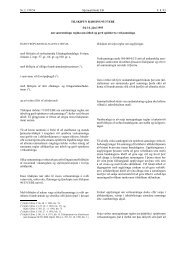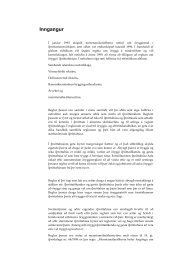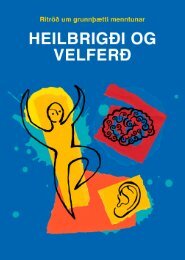Arts and Cultural Education in Iceland : Professor Anne Bamford
Arts and Cultural Education in Iceland : Professor Anne Bamford
Arts and Cultural Education in Iceland : Professor Anne Bamford
Create successful ePaper yourself
Turn your PDF publications into a flip-book with our unique Google optimized e-Paper software.
primary level exceptional students are given support that only to a limited degree meets their abilities <strong>and</strong><br />
needs. The senior managers of art schools <strong>and</strong> other relevant spokesmen of the arts have drawn attention<br />
to the problems associated with these discrepancies, but so far they have not suggested reasonable<br />
solutions that will constructively move the issue forward. (page 1)<br />
It may be the case – especially if economic conditions cont<strong>in</strong>ue to tighten – that<br />
consideration may need to be given to provid<strong>in</strong>g additional support to those of talent whose<br />
capacity to cont<strong>in</strong>ue their arts education may be detrimentally effected if parents can no longer<br />
afford the lessons. Conversely, other comments stress that the build<strong>in</strong>g of talent at a local level<br />
is help<strong>in</strong>g to generate a very robust <strong>and</strong> susta<strong>in</strong>able arts environment, as this comment<br />
summarises:<br />
Many talented children are com<strong>in</strong>g up because of <strong>in</strong>creased resources put <strong>in</strong>to arts education. Parents have<br />
been will<strong>in</strong>g to pay. It is important for the M<strong>in</strong>istry to realize this <strong>and</strong> not reduce support.<br />
In a general sense, though, fund<strong>in</strong>g for arts education is deemed to be sufficient <strong>and</strong> there is<br />
a very high st<strong>and</strong>ard of facilities for the arts both with<strong>in</strong> schools <strong>and</strong> more broadly with<strong>in</strong> the<br />
community. Figures 1.6.2a <strong>and</strong> 1.6.2b show a relatively high level of satisfaction with the<br />
provisions of specialist arts facilities, with dance danc<strong>in</strong>g record<strong>in</strong>g 88% as be<strong>in</strong>g very or rather<br />
good facilities <strong>and</strong> music report<strong>in</strong>g 67% as be<strong>in</strong>g rather or very good facilities:<br />
Figure 1.6.2a: How well or poorly are the school's facilities suited for teach<strong>in</strong>g (dance)<br />
Figure 1.6.2b: How well or poorly are the school's facilities suited for teach<strong>in</strong>g (music)<br />
1.7 Management<br />
‣ Young people could be more actively <strong>in</strong>volved <strong>in</strong> decision mak<strong>in</strong>g<br />
Management of most schools <strong>and</strong> cultural <strong>in</strong>stitutions is through quite autonomous Board<br />
structures. These boards tend to be made up of staff, parents <strong>and</strong> community members. The<br />
voice of young people is rarely represented directly on the Board structure, though there is<br />
generally a comparatively high proportion of ‘student associations’ or similar that exist <strong>in</strong><br />
Icel<strong>and</strong>ic schools. It is unclear the extent to which the student associations provide an<br />
opportunity for shared plann<strong>in</strong>g <strong>and</strong> priority sett<strong>in</strong>g (“The teachers usually plan. We get a bit<br />
25



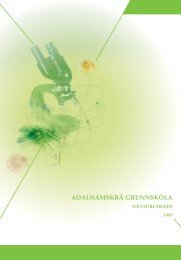
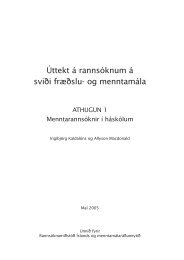

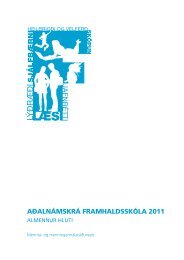
![Aðalnámskrá tónlistarskóla : rytmÃsk tónlist [Eingöngu á rafrænu formi]](https://img.yumpu.com/50843672/1/184x260/aaalnamskra-tanlistarskala-rytma-sk-tanlist-eingangu-a-rafranu-formi.jpg?quality=85)



